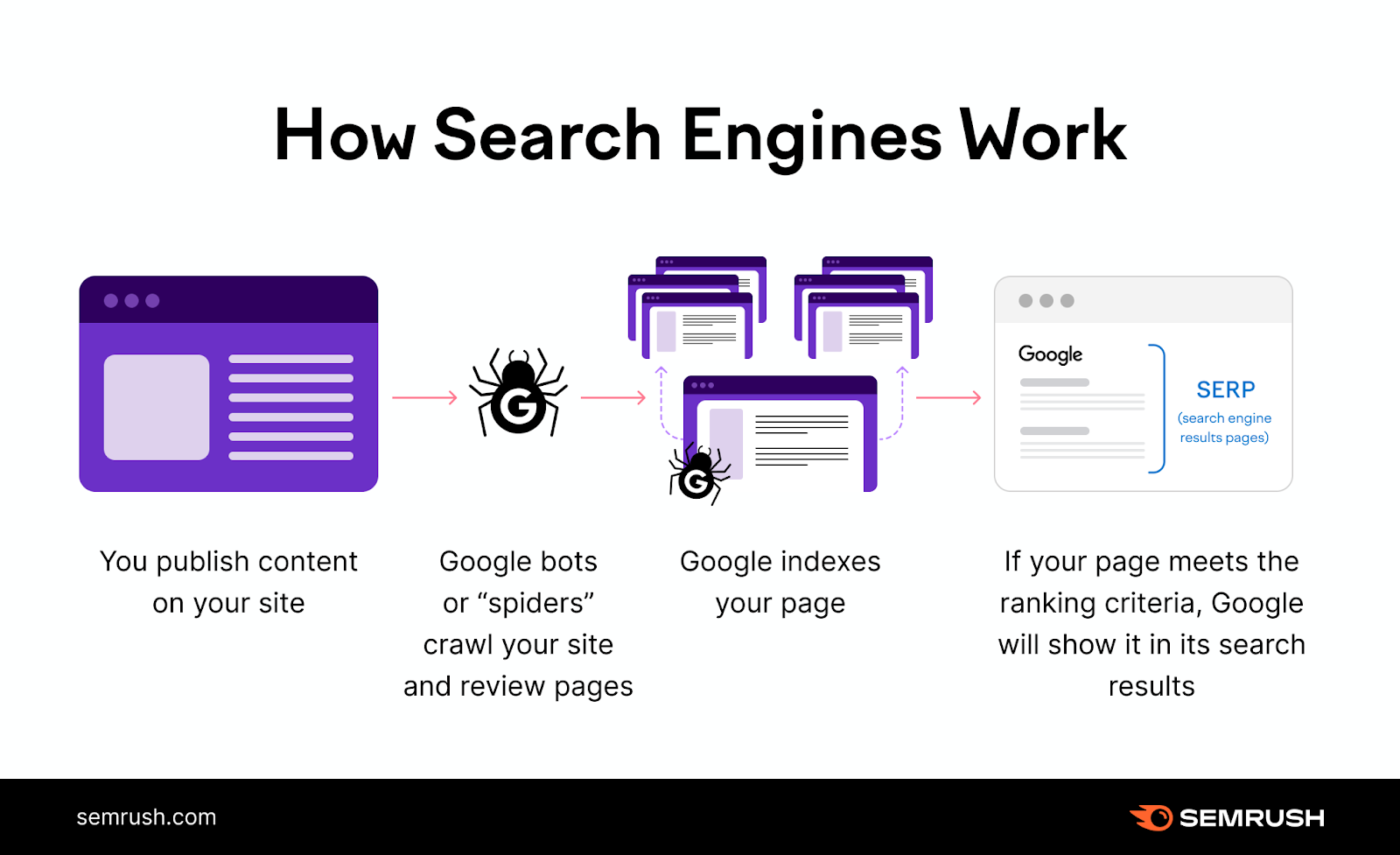To use Search Engine Optimization (SEO) in a website, focus on keyword research and quality content creation. Optimize on-page elements like meta tags and headings.
Search Engine Optimization (SEO) enhances your website’s visibility on search engines. It involves strategic use of keywords, quality content, and technical improvements. Effective SEO attracts organic traffic, boosting your site’s rankings. Start by researching relevant keywords your audience uses. Incorporate these keywords naturally into your content, titles, and meta descriptions.
Ensure your site is mobile-friendly and has fast loading times. Quality backlinks from reputable sources also improve your site’s authority. Regularly update your content to keep it relevant. Use analytics tools to monitor performance and adjust strategies as needed. Consistent SEO efforts lead to better online visibility and increased traffic.
Seo Basics
Understanding SEO Basics is crucial for any website owner. It helps improve your site’s visibility and ranking on search engines. In this section, we will cover the fundamentals of SEO, including its definition and importance.
What Is Seo?
SEO stands for Search Engine Optimization. It’s a process that aims to improve your website’s ranking on search engines like Google. This involves various strategies and techniques to make your website more attractive to search engines. The goal is to increase organic traffic to your site.
Here are some key aspects of SEO:
- Keyword Research: Identifying the terms users search for.
- On-Page SEO: Optimizing individual pages on your website.
- Off-Page SEO: Building backlinks to your site.
- Technical SEO: Improving the technical aspects of your site.
Importance Of Seo
The importance of SEO cannot be overstated. It directly impacts your website’s visibility and traffic. Without SEO, your site may remain invisible to potential visitors.
Some reasons why SEO is important:
- Increased Visibility: Helps your site appear in search results.
- Higher Traffic: More visibility means more visitors.
- Better User Experience: SEO improves site navigation and speed.
- Credibility and Trust: Higher rankings build trust with users.
SEO is not a one-time task. It requires ongoing effort and attention. Regular updates and monitoring are essential for sustained success.
Keyword Research
Keyword research is the backbone of effective Search Engine Optimization (SEO). It helps you understand what your audience is searching for. This knowledge guides your content creation and optimization efforts. Let’s dive into the key steps involved in keyword research.
Finding The Right Keywords
Start by brainstorming a list of words related to your business. Think about what your audience might type into search engines. Use tools like Google Keyword Planner and Ubersuggest to expand this list.
- Enter your main topic into these tools.
- Get suggestions for related keywords.
- Look for keywords with high search volume and low competition.
These tools also provide valuable data. They show how often each keyword is searched. This helps you prioritize which keywords to target.
Analyzing Keyword Competition
Once you have a list, analyze the competition for each keyword. This step is crucial to understand how hard it will be to rank for each keyword.
Use tools like Ahrefs and SEMrush to check keyword difficulty. These tools give a score based on how competitive a keyword is.
Create a table to organize your findings:
| Keyword | Search Volume | Competition Level | Difficulty Score |
|---|---|---|---|
| Keyword 1 | 1000 | Low | 20 |
| Keyword 2 | 500 | Medium | 40 |
| Keyword 3 | 2000 | High | 70 |
Focus on keywords with a lower difficulty score. These are easier to rank for and can bring in more traffic.
On-page Optimization
On-page optimization is crucial for improving your website’s search engine rankings. It involves optimizing individual web pages to rank higher and earn more relevant traffic. By focusing on specific elements, you can ensure your content is both user-friendly and search engine friendly. Two key aspects of on-page optimization are optimizing title tags and improving meta descriptions.
Optimizing Title Tags
Title tags are one of the most important on-page elements. They tell both users and search engines what the page is about. Here are some tips for optimizing your title tags:
- Include your primary keyword near the beginning of the title.
- Keep the title length between 50-60 characters.
- Make sure each page has a unique title tag.
- Use descriptive and compelling language to attract clicks.
For example, if your website is about gardening tips, a good title tag could be: .
Improving Meta Descriptions
Meta descriptions provide a brief summary of the page content. They appear below the title tag in search engine results. A well-crafted meta description can increase click-through rates. Here are some tips for writing effective meta descriptions:
- Include your primary keyword in the meta description.
- Keep the description between 150-160 characters.
- Write in a concise and engaging manner.
- Use actionable language to encourage clicks.
For example, a good meta description for a gardening tips page could be: .
By focusing on title tags and meta descriptions, you can significantly improve your on-page SEO and attract more visitors to your site.

Credit: www.rgbwebtech.com
Content Creation
Creating engaging content is essential for SEO. Quality content attracts visitors. It keeps them on your website longer. This section covers how to create high-quality content and use keywords naturally.
Creating High-quality Content
High-quality content is valuable and informative. It answers questions your audience might have. Use clear and concise language. Make sure your content is easy to read.
Follow these tips for high-quality content:
- Write original content.
- Ensure your content is well-researched.
- Use short paragraphs and sentences.
- Include images and videos where relevant.
- Update your content regularly.
Using Keywords Naturally
Keywords are essential for SEO. They help search engines understand your content. Use keywords naturally in your text. Avoid keyword stuffing. It can harm your ranking.
Here are some tips for using keywords:
- Use primary keywords in titles and headings.
- Include keywords in the first 100 words.
- Spread keywords throughout your content.
- Use synonyms and related terms.
- Ensure keywords fit naturally in sentences.
Use a table to organize your keywords:
| Primary Keywords | Secondary Keywords | Related Terms |
|---|---|---|
| SEO tips | SEO strategies | search engine optimization |
| content creation | content marketing | blog writing |
| keyword research | keyword tools | SEO keywords |
Remember to keep your audience in mind. Write for people first, then for search engines.
Technical Seo
Technical SEO involves optimizing your website for the crawling and indexing phase. It helps search engines access, crawl, interpret, and index your website without any problems. This aspect of SEO focuses on the backend structure and foundation of your website. By improving technical SEO, you ensure that your website meets the requirements of modern search engines.
Improving Site Speed
Site speed is crucial for user experience and SEO. Users expect fast-loading websites. Slow websites lead to higher bounce rates. Search engines rank fast websites higher. Here are some tips to improve your site speed:
- Optimize images by compressing them without losing quality.
- Use a Content Delivery Network (CDN) to serve content faster.
- Minimize HTTP requests by reducing the number of elements on a page.
- Enable browser caching to store static files locally.
- Use asynchronous loading for JavaScript files.
- Minify CSS, JavaScript, and HTML files.
Utilize tools like Google PageSpeed Insights and GTmetrix to check your site’s speed. These tools provide actionable insights to enhance your site’s performance.
Ensuring Mobile Friendliness
Mobile friendliness is essential in today’s digital world. A large number of users access websites via mobile devices. Ensure your website is mobile-friendly for better user experience and SEO. Here are some steps to make your site mobile-friendly:
- Use responsive design so your website adjusts to different screen sizes.
- Implement a mobile-first design approach.
- Ensure text is readable without zooming in.
- Make buttons and links easily tappable.
- Avoid using Flash, as it is not supported on many mobile devices.
Test your website’s mobile-friendliness using Google’s Mobile-Friendly Test. This tool helps identify areas that need improvement.
Technical SEO is critical for your website’s success. By improving site speed and ensuring mobile friendliness, you boost user experience and search engine rankings. Take the steps outlined above to optimize your site’s technical aspects.

Credit: searchengineland.com
Link Building
Link building is a crucial part of Search Engine Optimization (SEO). It involves getting other websites to link to your website. This can improve your site’s visibility and ranking on search engines. Quality links from other sites can boost your site’s authority.
Earning Backlinks
Earning backlinks is about getting other websites to link to your content. Start by creating high-quality content that people want to share. This can be blog posts, infographics, or videos.
You can also reach out to other website owners. Ask them to link to your content if it’s relevant to their audience. Guest posting is another effective method. Write articles for other websites and include a link back to your site.
| Method | Description |
|---|---|
| High-Quality Content | Create valuable content that others want to share. |
| Outreach | Contact website owners to link to your site. |
| Guest Posting | Write for other sites and include your links. |
Avoiding Toxic Links
Not all links are good for your website. Some links can harm your site’s ranking. These are known as toxic links. Toxic links usually come from spammy or low-quality websites.
To avoid toxic links, use tools to monitor your backlink profile. Tools like Ahrefs or SEMrush can help you find and remove bad links. If you find toxic links, you can use the Google Disavow Tool. This tells Google to ignore those links.
- Use backlink monitoring tools.
- Identify and remove toxic links.
- Use Google Disavow Tool for harmful links.
Monitoring Performance
Monitoring the performance of your SEO efforts is crucial. It allows you to identify what is working and what needs improvement. By keeping a close eye on your website’s performance, you can make data-driven decisions and continually optimize your strategy for better results.
Using Analytics Tools
Using analytics tools helps track your website’s performance. Google Analytics is a popular choice. It provides insights into user behavior, traffic sources, and page performance. Setting up Google Analytics is simple.
- Create a Google Analytics account.
- Add your website as a property.
- Install the tracking code on your website.
Explore important metrics in Google Analytics such as:
- Organic Search Traffic: Tracks visitors from search engines.
- Bounce Rate: Measures the percentage of visitors who leave after viewing one page.
- Average Session Duration: Shows how long visitors stay on your site.
- Pages per Session: Indicates how many pages visitors view per session.
Another useful tool is Google Search Console. It helps you monitor and troubleshoot your website’s presence in Google Search results. Key features include:
- Performance Reports: View clicks, impressions, and average position.
- Index Coverage: See which pages are indexed by Google.
- URL Inspection: Check if a page is indexed or has errors.
Adjusting Strategies
Based on your analytics, you may need to adjust your strategies. Look for pages with high bounce rates. Improve their content to keep users engaged. If a page has a low average session duration, make it more informative. Add visuals and internal links to increase time spent on the page.
Check your keyword rankings. If certain keywords are not performing well, consider targeting new ones. Use tools like SEMrush or Ahrefs to find better keywords. Optimize your content with these new keywords. Track the changes in your rankings over time.
Regularly review your backlink profile. Use tools like Ahrefs or Moz to analyze your backlinks. If you have toxic backlinks, disavow them to maintain a healthy link profile.
Lastly, update your content regularly. Fresh, updated content can boost your SEO. Review your top-performing pages and refresh them with new information.
| Metric | Action |
|---|---|
| Bounce Rate | Improve content, make it engaging |
| Session Duration | Add visuals, internal links |
| Keyword Rankings | Target new keywords, optimize content |
| Backlinks | Disavow toxic backlinks |
Effective monitoring and adjustments lead to better SEO results. Stay proactive and continually refine your strategies for success.

Credit: www.semrush.com
Frequently Asked Questions
How To Use Seo On A Website?
Optimize your website by using relevant keywords, creating quality content, improving site speed, ensuring mobile-friendliness, and building backlinks.
How Do You Optimize A Website For Search Engines?
Optimize a website by using relevant keywords, creating quality content, improving site speed, building backlinks, and ensuring mobile-friendliness.
How To Do Seo For Beginners?
Start with keyword research using tools like Google Keyword Planner. Optimize your titles and meta descriptions. Create high-quality, engaging content. Use internal and external links. Monitor and analyze your SEO performance regularly.
How To Improve Seo Of A Website?
Improve website SEO by using relevant keywords, creating quality content, optimizing meta tags, improving site speed, and getting backlinks.
What Is Seo In Website Development?
SEO stands for Search Engine Optimization. It helps improve your website’s visibility on search engines like Google.
Conclusion
Mastering SEO can boost your website’s visibility and traffic. Implementing these strategies ensures your site ranks higher. Stay updated with SEO trends and practices. Consistent effort will lead to long-term success. Use these tips to enhance your website’s performance and achieve your digital marketing goals.


